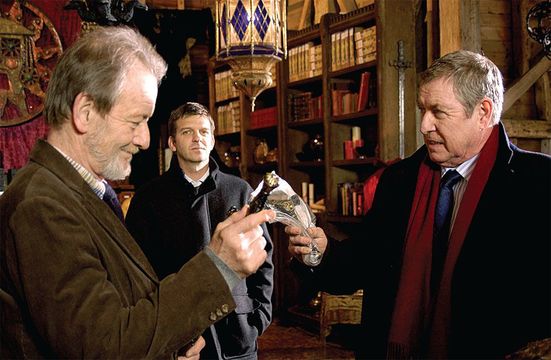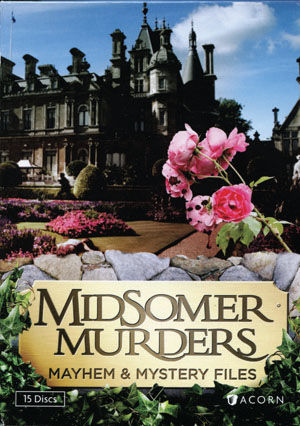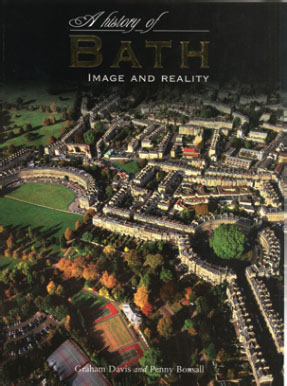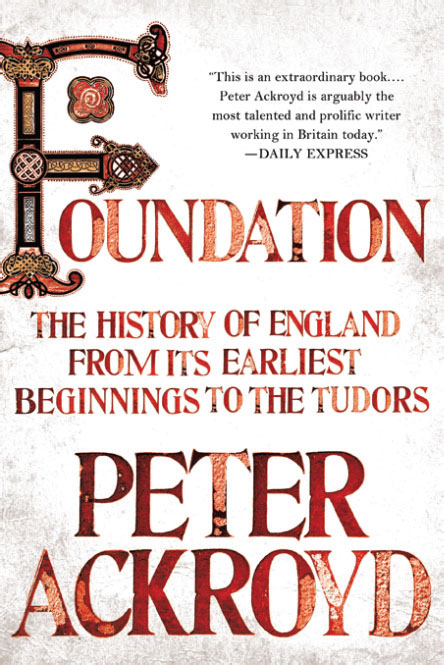
DCI Barnaby (John Nettles) confronts the villain (Ronald Pickup) in “The Magician’s Nephew,” while Sgt. Jones (Jason Hughes) looks on.
There are a lot of bodies lying around in the pastoral English countryside of the fictional county
Quirky crimes and sinister secrets haunt the cozy villages of Midsomer—delightfully. Against a backdrop of heart-of-England scenery inhabited by quintessentially English characters, Midsomer Murders has retained its popularity for 15 [this article was originally published in 2016] seasons on Britain’s ITV—even the Queen is a fan. It’s little wonder that the stories have been Acorn Media’s top-selling series for the last several years.
This latest anthology contains 15 standalone, feature-length episodes in their original broadcast order. They are all delightful. That alone tells us something about the series: It’s a formula you either love or hate. The setting is a largely idealized rural England. In fact, the series has been criticized for portraying too “English” a world. There’s nothing multicultural about Midsomer with the exception of the Barnabys’ occasional curry. Our hero, DCI Tom Barnaby (John Nettles) is an affectionate family man, just irascible enough to be human, with just enough family life to be believable. It’s all solid English values under an English sky here.
That world may not be to everyone’s taste, but it does reflect the nostalgic longings of millions at home in Britain—and around the world.
The innocent English society of Midsomer is rent asunder by the vilest intrusion of the ultimate human-to-human crime: murder (and often several of them before we’re done). The good guys of Causton CID, fronted by Tom Barnaby, accompanied by his sergeant sidekick Ben Jones and a cast of several, and after sundry plausible red herrings, arrive at the truth. They see that justice has been served and order restored to the social hive of Midsomer.
DVD
Midsomer Murders: Mayhem & Mystery Files, 15-disc set, Acorn Media, Silver Spring, Md., 15 episodes, app. 25 hours, &doller;149.99
[caption id="SecretsofthePastLiveoninMurkyMidsomer_img2" align="alignright" width="300"]

Yes, Midsomer Murders are more caricature than accurate depiction, as “Murder Most Midsomer” points out. These features, though, are nonetheless loveable, stylish and visually attractive. If you’ve not done so, do at least pay a visit to Midsomer.
Jane Austen Meets the Romans
WHAT’S NOT TO LIKE about Bath? Just an hour by train from Paddington Station or a couple of hours from London by car west along the M4, Bath is one of Britain’s most popular tourist destinations. The small, compact city is teeming throughout the year with visitors from around the world.
The famous Roman Baths complex (the most complete illustration of Roman life in Britain) receives some 4 million visitors a year. The city’s neat Georgian squares and crescents, public buildings like the Pump Room, Bath Abbey, the Assembly Rooms and Theatre Royal, flower-decked pedestrian precincts, some 300 antique dealers and plethora of museums are all easily manageable on foot—though not without some serious gradients. With a long popular tradition as a visitors center, Bath has a superb tourism infrastructure of hotels and lodgings, restaurants of every description, pubs and shops. After all, Bath has been drawing recreational travelers for 2,000 years.
There is a lot of history to be told. A History of Bath: Image and Reality tells it superbly. On the one hand, the city’s unique role, first as a Roman spa and then as an 18th-century social center, gave it specific eras of glory, and largely provided the character of the city we see today. On the other hand, as a small provincial city (population circa 85,000), Bath also provides a microcosm of English social history through the centuries. Each of these elements of the modern city’s past are explicated here in a readable, and often intriguing, narrative.
BOOK
A History of Bath: Image and Reality by Graham Davis and Penny Bonsall, Carnegie Publishing, Lancaster, 336 pages, hardcover, &doller;31.95.
[caption id="SecretsofthePastLiveoninMurkyMidsomer_img3" align="alignright" width="287"]

This is not “the story of Bath,” however; this is serious history. It reflects a huge amount of research, with a good deal of statistical reporting and analysis. In some cases, that can be dry and off-putting. Davis and Bonsall, though, skillfully weave an interesting tapestry. The book is lavishly illustrated, with hundreds of photos (both contemporary and historic), maps, drawings and sidebars providing vignettes of Bath life and personalities. Bath is one of England’s most fascinating cities; this excellent history convincingly unpacks the how and why.
BOOK
Foundation: The History of England From Its Earliest Beginnings to the Tudors by Peter Ackroyd, Thomas Dunne Books, New York, 495 pages, hardcover, &doller;29.99.
AMONG THE MOST PROLIFIC and honored English writers today, Peter Ackroyd has turned his hand to novels, biographies and history. Through a 40-year writing career, Ackroyd’s principal and much-loved canvas has been London. This time, he has turned his deft hand to a broader and more complex theme—the epic story of England’s development from pre-history to the Renaissance.
The more recent history is, the easier it is to write, in that source materials, firsthand accounts and the physical evidence are more abundant. Beginning in the “mists of time,” however, affords scanty physical evidence and no written accounts at all. From the start of his narrative, though, Ackroyd constructs a cogent, coherent picture evoking a time and place that might begin in the mist but emerges into the recognizable nation that developed through three centuries of Plantagenet kings. It works, because Ackroyd is a vivid storyteller, not an academic.
The very readable story that results is one not just of kings, barons, politics and martial adventure, but of how people lived, what motivated them and, in essence, how the English worldview evolved. There is certainly no shortage of English histories available for readers, many of them excellent in their own way. (It’s hard to replace Churchill’s four-volume History of the English-Speaking Peoples, for instance.) And it might have been more duly modest to term Foundation “a history,” rather than “the history.” Still, Foundation has received much praise, and deservedly so. This is a gripping good read and offers a colorful overview of 3,000 years with a verve and comprehension that few writers could provide.
[caption id="SecretsofthePastLiveoninMurkyMidsomer_img4" align="aligncenter" width="444"]

Ironically, Ackroyd himself illustrates that history is a vital rather than a static subject, that the final story is never told. After all, he disposes of King Richard III with a sentence: “The coffin was later used as a horse trough, and the bones of Richard III scattered.” It seems those bones are rewriting history even today.





Comments